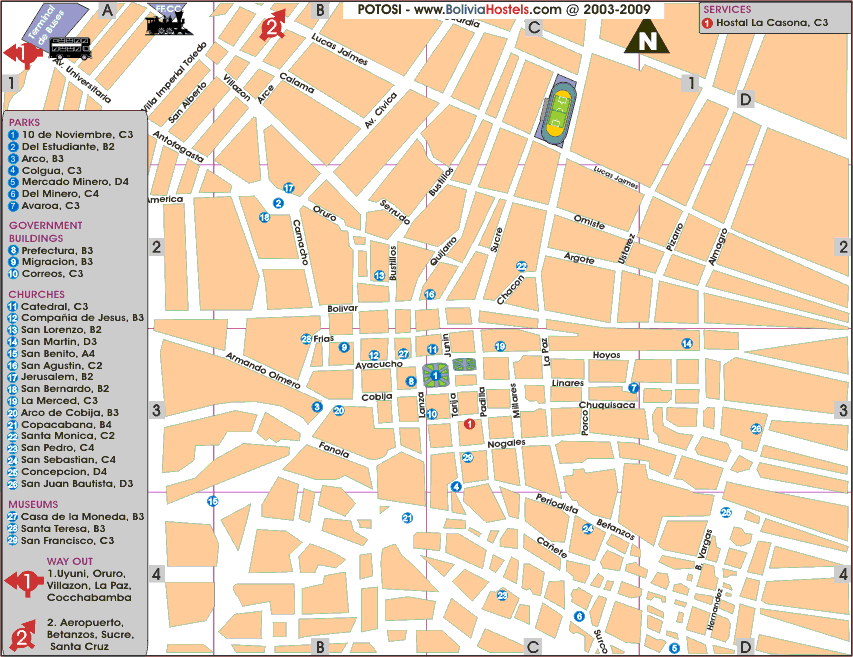Potosi Travel Guide
Wide information about Potosi and surroundings
1. History of Potosi.

Visiting guests, the people of Potosi are pleased to give you a very warm welcome to our Imperial City. This guide is made to make your stay in our city and Hotel La Casona pleasant and interesting. You will be able to find information on tourist attractions and essential services offered by our city for its visitors.
With regards to the name of Potosi, some chroniclers say that when the Inca Huaya Capac sent people to work the mines of Sumaj Orcko, they heard a terrifying sound and a voice that said: do not take the silver from this mountain because it is meat for others. They were surprised and went to tell the Inca what had happened using the word Ppotojsi which in Quechua means burst. This event took place 83 years before the arrival of the Spanish in Potosi in 1545 and the consequent exploitation of the mountain.
Potosi is proud of being able to offer its visitors a rich historic heritage, architecture an art which deserve the title, bestowed by UNESCO in 1987, as the Patrimony of Humanity and the name Monument City of America by OEA. The Cerro Rico and its contents (mines, mills and lagoons) as well as numerous religious, civil and administrative buildings give testimony to this and preserve much of the time of viceroyalty. In this guide you will be able to become acquainted with the monuments and the most important and significant places of the city through a small explanatory summary of the most relevant facts.
The city is interconnected with the main cities of the country by roadsthat join Potosi to Sucre (the capital of Bolivia), Oruro, Cochabamba and La Paz (the administrative capital), as well as by trains and by air.
The city is interesting calendar of activities to tourism, in which you will find Carnival, Chutillos, International Cultural Festival (which takes place every two years), and others of mainly religious nature whose details can be found in the festivities section of this guide.
This guide also gives a detailed explanation of services and directions which will make your stay in the city more comfortable.
2. Basic Information About Potosi.
Emergency Tourist Police has a small 'quisco' at the boulevard street. Report thefts to obtain a 'denuncia' (affidavit) for insurance purposes - they will not recover any stolen goods.
Immigration (T. calle Calama and Av. Civica) for visa extensions and others..
Internet Access There are many places to get online, including Hostal La Casona Potosi (calle Chuquisaca # 460). All places charge 2 BOB/hour. Wi-Fi only Hostal La Casona Potosi.
Laundry Most hotels can organize laundry services for their guests. Failing that, try Hostal La Casona Potosi (calle Chuquisaca # 460; 8 BOB/kilo).
Medical Services If you need an English-speaking doctor visit GESSBA, they offer visits to hotels and provide ambulance services.
Money ATMs are common in the center of town. Lots of businesses along Bolivar, Sucre and in the market change US Dollars at reasonable rates. Cash advances are available at Banco de Credito (Bolivar and Sucre) and Hostal La Casona Potosi (Chuquisaca # 460).
Post and Telephone The central post office (Lanza and Chuquisaca) is close to the main square. There are numerous call centers with cheap international rates.
Tourist Information Direccion de Turismo (Ayacucho near Bustillos, T. 6225288, 8:30-12:00 and 14:00-18:00) Located up the stairs in the beautiful Torre de la Compania de Jesus. Very helpful.
Electricity 220V.
Book Exchanges For used paperbacks in English try Hostal La Casona Potosi (calle Chuquisaca # 460). Other option a travel agency in front to Casa de la Moneda.
3. Weather in Potosi.
By Bolivian standards, Potos is chilly (particularly at night) and it's one of the few big cities where you'll see snow. What little rain there is falls mostly in summer and, although the temperature range throughout the day can be great, it varies little from month to month.
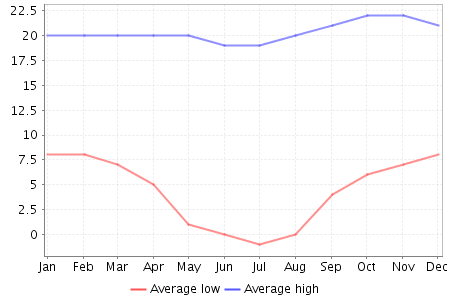
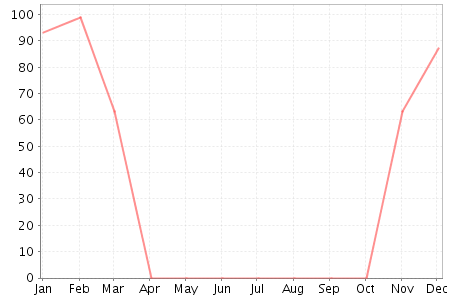
4. The City of Potosi.
a) The Royal Mint.
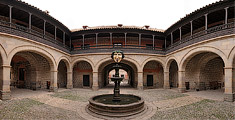
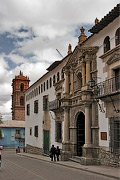
Don Francisco de Toledo. Viceroy of Peru ordered the construction of the first Mint in 1572 which proved to be insufficient for the coinage of the massive quantity of silver proceeding from Cerro Rico. It is for construct another Mint capable of meeting the needs of coinage.
This important building, built of stone, brick, tiles and cedar wood, has a surface area of 7570 squared meters. One can gain access to it through a beautiful entrance of mannerist style.
The Mint House of Potosi is considered as the most important civil building of Latin America. From the outside, the building looks like a virtual fortress. On the inside, the patios are decorated with arches, wooden balconies and ample eaves.
The national Mint presently serves as a museum and historical archives. In the museum, one can appreciable the paintings of Perez de Holguin, Gamarra, Berrio and Cruz, among others. The tour offers visits to halls of numismatics, alter pieces, mineralogy, ethnology, handicrafts, etc.

b) The Cathedral
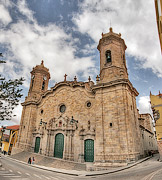
The primitive major Church had been initiated 1564. The temple of a single aisle, collapsed in 1807. The present Cathedral, which occupies the same space as its predecessor, is the work of architect Fray Manuel de Sanahuja who started it in 1808. It was inaugurated in 1836.
The Cathedral of Potosi is a magnificent temple of Baroque style. It is considered as one of the most beautiful examples in a series of great Cathedrals of Latin America. On the inside, the concept is polychrome which today calls the attention to the gold mouldings on a white background and the bases of the bases of the columns, where one can still observe tiles originating from Jesuit Churches.
Among the colonial art pieces that belong to the first church, one can find the four wooden medallions of high relief, placed above the interior doors. The reliefs of The Assumption can be found in the Trinity alter, and The Coronation of the Virgin in the baptistery.
c) Santa Teresa Church
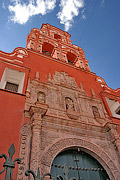
In 1685 the work was initiated. The construction of the church and convent took seven years.
Above the entrance are preserved three coats of arms, the central one corresponding to the Order of the Carmelites and the two on the sides to the co-founders whose portraits can be found in the same convent. The atrium of the church, which had been closed off by walls finished off in festooned arches and half-point arches, was replaced in the middle of this century by round pillars of stone and iron railings.
The temple It is of a single aisle covered with a wooden framework and divided by an Arc de Triumph of cedar wood, recovered by gold plating and polychroming.
The facade is made up of a portal, foreshadowing the so called Mestizo Style, and a belfry which is the first example of this type of bell tower that abound in the Imperial City.
The museum is installed in the and second cloisters of the convent, which maintains its viceroyal architecture, and displays one of the best pictorial collection in the country. We have to add alter pieces, wood carvings, rich materials, furnishings, books, relics, silverware and diverse objects from the seventeenth and eighteenth cemturis.
At the end of your visit you will be able to buy quesitos which are marzipan sweets prepared by nuns like three centuries ago.
d) San Francisco Church
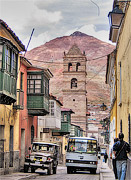
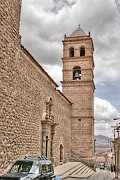
The monastery of San Francisco (St. Antonio of Padua) was founded in 1547 by Friar Gaspar de Valverde. In 1707, the old church was destroyed and the building of a new one was initiated. It was inaugurated in 1726, is the oldest cloister in Bolivia.
Medallions representing St. Francis, Popes, a Sacred Heart, a sign of marine are the outstanding features of the first aisle.
A series of 25 paintings of Gregorio Gamarra on the life St. Francis of Assis complete the tour of the cloister.
The church is made up of three aisles covered with cannon vaults and nine orange colored domes, featuring a beautiful Baroque front entrance which is the work of the Indian stone-cutter Sebastian de la Cruz, and another on the side which shelters a cross.
The antechambers of the vestry contains canvasses of anonymous authors such as The Flagellation, The Holy Virgin of the eighteenth century, and between them a wood-carving which represents the Prayer of the Garden, and The Virgin of Aranzazu work of the sculptor Luis Espindola. In the vestry, one can see the most outstanding work of Melchor Perez de Holguin The Erection of the Cross.
The belvedere, whose structure allows the visitors to admire the beauty, of the city and the mountain, is a predominant feature of its roof.
e) Church of Bethlehem
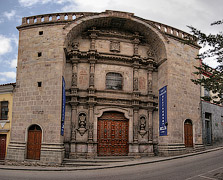
The Bethlemite religion came to Potosi in 1700 and since its aim was to take care of hospitals of Real de la Vera Cruz which today is in a very bad state, was handed over to them. Thus the Order of Our Lord of Bethlem of Potosi was founded. The building fell down in 1725 due to heavy rain falls. The work of the new church was given to Bernardo Rojas Luna y Salda a and was concluded in 1753.
In 1826, Marshal Sucre created the Faculty of Arts and Sciences of Potosi using the Bethlemite hospital as its premises.
In 1862. It was converted into a public theatre and in the twentieth century into a movie theatre. Today it functions as a theatre thanks to its restoration which won the first Junta de Andaluc a award and the ninth Bienal Panamericana of Architecture of Quito en 1994.
f) San Martin
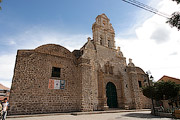
This church was constructed for the indigenous who came from diverse places to carry out their obligatory enforced service in the mines. It belonged to the Mercederian Order.
The first construction dates to 1592. Its original structure features only one aisle with mud brick waits, a back to back tower, atrium and passing bell chapels.
The temple is a mixture of mestizo art that is preserved according to Baroque criteria of integration between architecture and painting.
5. Around Potosi.
a) The Lagoons
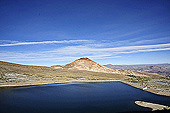
At the beginnings, the mineral was taken to the water provision for its grinding but the difficulties related to the distance of transportation forced to Viceroy Toledo to adopt and construct a system of damming, in 1572, which later crated a network of reservoirs and waterways in order to lessen the difficulty of having to take the mineral long distance for grinding.
The first lagoon to be used was Chalviri. In 1576, the Kari-Kari lagoon, also know a San Ildefonso and Sebastian were dug up. This last one had a permanent water outlet which created the ribera, an artificially channeled river which provided the mills and the city s pipes with water.
The lagoons of S. Ildefonso and S. Sebastian are near the mountain and three are dirt roads which lead you to them. It is necessary to rent a vehicle or taxi in the city.
b) La Puerta
Is a locality near Potosi (6km on the road to Oruro). On the way to this place, one passes the famous Devil's Cave. The area has interesting geological structures of red and colorful soil and rocks. In La Puerta one can find the Chapel of St. Bartholomew built in 1598 and d the Calvary.
Microbuses leave Chuquimia Square from eight in the morning until midnight, every half hour, and every day to this place.
c) La Palca
Is a modern tin volatilization plant which uses a pyrometalurgical process situated about 1km distance from the road to La Paz (km9). Presently it is not functioning. To go there one needs to obtain a vehicle (either rent one or use a taxi).
d) Tarapaya Lagoon
Is approximately 23km from Potosi on the way to La Paz, where one can find a circular volcanic boiler of hot spring water that ever since pre-columbian times has also been known as Ba o del Inca (Inca's Bath). It is a perfect circle of about 100m in a diameter that instead of spewing lava, emanates hot water. It was made famous by the Incas and later by the installation of hot baths in Tarapaya which today may be enjoyed by all visitors. Access to it is via paved road requiring approximately 15 minutes of travel time.
Tarapaya complex has an Olympic size pool, privare baths and other facilities which provide comfort and food for the visitor. Public transportation goes to the baths and is the same as the one going to La Puerta.

e) Miraflores
Just 25km from town and at small distance from Tarapaya, Miraflores equally receives visitors who want to enjoy hot spring water and which also equipped with food services.
f) Cayara Farm
Is on the way to Tarapaya, taking a detour from the main road to La Paz, at 25km distance from the city. It is probably the best colonial hacienda preserved in Potosi.
Aside from visiting the rooms, paintings, furnishings and other objects, it is possible to stay the night.
g) Cantumarca
At a 3km distance on the way to Uyuni, one can encounter this ancient, pre-inca and colonial times, Colla hamlet of vital historical importance. One can reach it by minibuses and micros that are leaving the city.
h) Chaqui
At 35km distance from Potosi, taking a secondary road from the main road to Sucre, one encounters the Hostel-Spa of Chaqui whose ferruginous waters are recommended for good health. To go to this place one can take public transportation which leaves from Uyuni Square.
i) Betanzos
An agricultural village situated 40km from Potosi, on the way to Sucre. It has attractions and curious Sunday fairs crowded by the people of the area. In these fairs, one can find woven, ceramic and metal objects and the beautiful original costumes.
j) Manquiri
At 30km distance from Potosi one can find this famous sanctuary, situated between red sandy mountains of simple beauty. It is visited by many pilgrims (see festivities calendar).
k) The Salt Desert of Uyuni
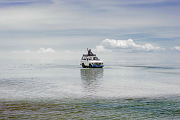
Uyuni it's at 219km from Potosi. It has an altitude of 3665 meters above sea level. The annual average temperature fluctuates from -25 C at night to 20 C during the day. It has an approximate population of 52000 inhabitants. The desert has a surface area of 10582km2. It is the largest salt desert of the world. One should mention its colorful volcanic mountains that reach altitudes of 6000 meters above sea level. The melting of the ice on their peaks, forms colorful lagoons due to the high content of copper. The finest birds inhabit this place. In the fish island, one can admire giant cacti (up to 9 meters in height).
The Red Lagoon Can be found at 327 km. of Uyuni at an altitude of 4278 meters above sea level. It is notable for the reddish color of its water and for the presence of geysers given that it is a volcanic region.
The Green Lagoon This salt water lagoon is situated at 4350 meters above sea level. The region has sulphuric mines. Travel agencies in Potosi and Uyuni organize visits to these wonderful spots.
6. Tours and Activities in Potosi
a) The Rich Mountain and The Mills

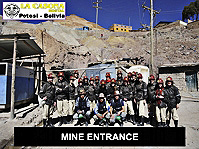
Is situated in the south of the city at a distance of 700 meters. Shaped like a regular conic, it is the landmark which symbolizes the city and is the only reason for its foundation.
Its cusp is at an altitude of 4828 meters above sea level, pegged in the Los Frailes cordillera.
In the mountain, which has suffered 450 years of continuous exploitation, exist about 300 mine entrances organized by administrations of private and cooperative mines.
The Pailaviri mine, situated at 4200 meters above sea level, is the most representative of the mountain. It is made up of 17 levels separated by 30 meters of distance between each. The temperature can fluctuate about 45 degrees Celsius between the exterior and the lowest levels.
The visit to the cooperative mines organized by travel agencies which provide you with transportation, clothing and tour guides.
The silver mills, whose constructions were initiated in 1572, were composed of 132 heads of 15 km. long thus becoming the largest industrial complex of the world at the beginning of the seventeenth century.
At the beginning of the exploitation of silver from the mountain, the silver was so fine that it was necessary to grind it and was possible to melt it directly in air ovens called Huayrachinas. When the mineral s fineness began to lessen, a system of amalgamation with (Azogue) was installed which required grinding before it could be mixed with the mercury.
This process architecturally required a large patio walled in by several dependencies, mineral storage, and storage mercury and other elements, smelting furnace room and a big wheel for grinding, moved hydraulically, which would put into motion a series of mallets that would grind the mineral in order to allow a better mixing also included adjoining housing and offices as well as a chapel.
The system, put into practice by Viceroy Francisco de Toledo, which devised the construction of dikes called lagunas, would supply the necessary water for the functioning of the mills.
The Potosi's Silver Mines Tours is a must tour to do in Potosi and you can do that with us. Please book in advance.
7. Festivals and Events.
January 1: New Year 's Day.
January 6: Twelfth Night. Transference of the agrarian command.
February or March (changeable date): Carnival.
Miners Carnival: The sacred statues of the miners are taken out of the mines once a year in this date and are taken to the Plaza el Minero (Miner s Square) which is a very symbolic place for the miners.
Compadres: 2 Thursday before Carnival.
Comadres: 1 Thursday before Carnival.
Carnival Parade: The Saturday of Carnival. It is a Folkloric Parade with music, dancing and costumes in all the streets of the city.
Martes de Ch alla: Tuesday of Carnival.
April (Changeable date): Easter.
Palm Sunday: The Saturday before Easter. People enter temples with branches which the clergy bless.
Holy Thursday: It is a tradition of the people to visit 12 temples of the city, one for each apostle, in this day.
Good Friday: Procession of the Holy Sepulchre.
June (Changeable date):
Corpus Christie: Commemoration of the Body of Christ. People traditionally sell typically regional sweets such as tahua-tahuas, sopaipillas , and chambergos as well as seasonal fruits such as oranges and peanuts.
Manquiri Feast: Religious feast which takes place from the last Sunday in May until the second Sunday in June. The faithful are blessed. People also bless their vehicles (according to tradition, so as to avoid accidents), and miniature objects (the blessed object will perform a miracle for its owner). People also sell handicrafts and go on pilgrimage, on foot to, to the place.
July 16: Feast of Carmen.
July 25: Rural Feast of Apostle Santiago.
August 24, 25 and 26: Feast of St. Bartholomew or Chutillos.
The Celebration lasts three days. The first day is called Chutillo, the second Majtillo and the third Tapuquillo. On the first day, people direct themselves to the locality of La Puerta (6 km. from the city along the road Oruro), in order to visit St. Bartholomew and raise the Calvary. On the second day three is a folkloric parade in the streets of the city where different groups from the different regions perform their dances and play their music. On the third day different fraternities of the city and the country as well as internationally invited guests perform their dances.
September 14: Feast of Se or de la Vera Cruz, Patron Saint of Potosi.
September 21: Day of Spring. Youth and Students of Bolivia.
First Sunday in October: Feast of the Virgin of Merced.
Second Sunday in October: Feast of the Virgin of Rosario.
On both dates, people perform a procession, decorate the streets and throw flower petals and confetti at the sacred statues, from their balconies.
October-November (Changeable date): International Cultural Festival.
Every two years, the cities of Potosi and Sucre invite different artists from, different parts of the country and the world.
November 1: Todos Santos (All Saints Day).
This is a pre-columbian tradition when the people go to visit the Tombs prepared at home by the relatives of the deceased and where the friends are offered the same food and drink liked by him.
November 2: Difuntos (Day of the Deceased)
The tombs are dismantled and the people celebrate in the memory of the deceased.
November 3: Alma Cacharpaya (Soul of the Calypsobreakers)
Those in charge of dismantling the tombs show up in the home of the deceased with an orchestra so that the soul of the deceased will be happy.
November 10: Anniversary of Potosi.
There are civic parades and in the evening, there are vervains in the main streets.
December 24 and 25: Christmas Eve and Christmas day.
8. Travel Companies and Tour Operators in Potosi.
Hostal La Casona (Chuquisaca # 460, T. 6230523) Besides mine tours to rich mountain, other popular options include Tarapaya and trekking and camping trips around the Lagunas de Kari Kari.
Andes Salt Expeditions (Plaza Alonso de Ibanes # 3, T. 6225175).
Koala Tours (Ayacucho # 5, T 6224708).
The Real Deal (Bustillos # 1044).
Silver Tours (Quijarro # 12, T.6223600).
Turismo Claudia (Ayacucho # 7, T.6225000).
9. Hotels and Hostels in Potosi.
Hostal La Casona (Chuquisaca # 460, T. 6230523, Website).
Hostal Colonial (Hoyos # 8, T. 6224265, Website).
Hotel Santa Teresa (Ayacucho # 43, T. 6225270, Website).
Hostal Las Tres Portadas (Bolivar # 1092, Website).
Hotel Jerusalen (Oruro # 143, T. 6224633, Website).
Macuquina Dora Hotel (Camacho # 243, T. 6230257, Website).
10. Restaurants and Bars in Potosi.
Dona Eugenia (Santa Cruz in corner Ortega, T. 6262247) Potosi residents swear by this convivial local restaurant at the northern end of town. Head there early to make sure you get some of the legendary Kala Purka (thick maize soup with a hot rock in it).
Manzana Magica (Oruro # 239) This is a worthwhile, strictly vegetarian spot known for its breakfast -muesli, juice, eggs and brown bread, and tasty soy steaks. Lunch is ultra-healthy and a la carte dinners are asserively spiced and portions are big.
4060 (Hoyos # 1, T. 6222623) It took us a while to work out the name, but we blamed the altitude (of Potosi in meters). This spacious conterporary cafe-bar is a newcomer on the scene and earning plaudits for its pizzas, burgers and mexican food and as a sociable spot for a drink. There is a good beer selection, but mixing lager with blue curacao in a cocktail struck us as highly dubious!.
La Casona Pub (Frias # 41, T. 6222954) The atmospheric pub is tucked away in the historic 1775 home of the royal envoy sent to administer the mint.
11. Getting There and Away.
Air At the moment no commercial flights to and from Potosi.
Bus All road routes into Potosi are quite scenic, and arriving by day will always present a dramatic introducion to the city. The new bus terminal is about 30 minutes by taxi from the center and it is located on the northwestern edge of town, in the barrio Las Lecherias. You can buy your ticket a Hostal La Casona (Chuquisaca # 460, T. 6230523).
- Sucre-Potosi-Sucre: (164 Km paved road) Daily departures at 7:00, 13:00, 17:00 and 18:00, 3 hours trip (20 BOB). Transtin Dil Rey and Real Audiencia are good bus companies options.
- La Paz-Potosi-La Paz: (450 Km paved road) Daily departures at 20:00 and 21:00, 9 hours trip (57 BOB to 115 BOB). Trans Copacabana MEM, Trans Copacabana SA are good bus companies options.
- Villazon-Potosi-Villazon (Border with Argentina): (400 Km paved and unpaved road) Daily departures at 20:00 and 21:00, 9 hours trip (57 BOB to 115 BOB). O Globo is the best company for this route.
- Uyuni-Potosi-Uyuni: (221 Km paved road) Daily departures at 11:00 and 18:30, 5.5 hours trip (39 BOB). Diana Tours is the best company for this route. Warning All buses to Uyuni leaves and arrives at Parada Uyuni, different place from Bus terminal.
- Oruro-Potosi-Oruro: (321 Km paved road) Daily departures at 7:00, 12:00, 13:30 and 22:00, 5.5 hours trip (30 BOB). Trans Azul is the best company for this route.
- Cochabamba-Potosi-Cochabamba: (464 Km paved road) Daily departures at 19:30 and 20:30, 9 hours trip (52-80 BOB). Trans Copacabana, Trans Bolivar are good options for this route.
- Santa Cruz-Potosi-Santa Cruz: Does not exist direct buses from Santa Cruz to Potosi, but you can get via Sucre or via Cochabamba.
Train (Sevilla) Trains to Sucre runs tuesdays, thursdays and saturdays at 8:00, 6 hours trip (25 BOB). Check in advance is the trains is running.
